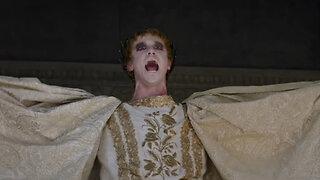Premium Only Content

Recitation of MY HEART LEAPS UP by William Wordsworth (Cockermouth, 1770-1850, Rydal Mount, England)
Biography
William Wordsworth (7 April 1770 in Cockermouth – 23 April 1850 in Rydal Mount) was the greatest English Romantic poet who, alongside Samuel Taylor Coleridge, helped to launch Romanticism in English literature with their joint publication in 1798 , from Lyrical Ballads (“Lyrical Ballads”).
The second of five children of John Wordsworth and Ann Cookson, William was born in Cockermouth, in Cumberland, in the Lake District, northwest England. His sister, the poet Dorothy Wordsworth, was born the following year, and the two were baptized together. The other brothers were Richard, the eldest, who would become a lawyer; John, born after Dorothy, who would become a poet and lover of nature, like his brothers, and who died in 1809, in the sinking of a ship where only the captain was saved; and Christopher, the youngest, who would become an academic.
William's father was a legal representative of “James Lowther, 1st Earl of Lonsdale” and, due to his connections, lived in a spacious small town mansion. William, like his brothers, had little involvement with their father and remained distant from him until his death in 1783. [1] The father, though rarely present, taught his son poetry, including Milton, William Shakespeare, and Edmund Spenser; moreover, he entrusted his son with his own library.
William sometimes spent time with his mother's relatives at Penrith, Cumberland, where he was influenced by the moors and countryside, as well as by the rough treatment of his relatives, particularly his grandparents and uncle, whose hostility so embittered him that consider suicide.[2]
After his mother's death in 1778, his father sent him to "Hawkshead Grammar School", and Dorothy went to live with relatives in Yorkshire; she and William did not see each other for the next nine years. Before Hawkshead, William had been educated at Cockermount and Penrith, where he met the Hutchisons, including Mary, who would become his wife.[3]
Wordsworth made his literary debut in 1787 when he published a sonnet in The European Magazine. In the same year he began to study at Cambridge and graduated with a degree in Arts in 1791. He returned to Hawkshead for his first two summer holidays, which he spent taking walks in nature. Between the years 1790 and 1792 he traveled across Europe, visiting the Alps, France, Switzerland and Italy.
In 1791, William converted to the French revolutionary ideal, joining republican movements. He fell in love with a Frenchwoman, Annette Vallon, who in 1792 bore him a daughter, Caroline. The following year, due to tensions between his country and France, he returned to England [4] and was unable to see his wife and daughter for many years. During this period he fell in love with Mrs. Gannon. With the Peace of Amiens William was able to go to France again, in 1802, and together with his sister Dorothy he visited Annette and Caroline. In 1835, Wordsworth gives Annette and Caroline their livelihood money.
Criticism
The origin of Wordsworth's philosophical devotion is articulated in The Prelude and every short work by him, like "Lines composed a few miles above Tintern Abbey", for example, has been the subject of much debate. While some have supposed that Wordsworth's philosophy was derived from Coleridge, more recently it has been suggested that his ideas began some years earlier, and the friendship with Coleridge began in 1790. During the revolutionary ideal, in the Paris of 1792, aged 22 , Wordsworth became aware of the mysterious traveler John "Walking" Stewart (1747–1822),[8] who was nearing the end of the 33-year pilgrimage that began in Madras, India, through Persia and Arabia, across Africa and Europe, and across the US. By this time Stewart had published an ambitious work of materialist philosophy entitled The Apocalypse of Nature (London, 1791), from which many of Wordsworth's philosophical sentiments were influenced.
Death
Tomb of William Wordsworth, Grasmere, Cumbria
William Wordsworth died of an aggravation of pleurisy on April 23, 1850 and was laid to rest at St. Oswald, in Grasmere. His widow Mary published her long autobiographical poem "poem to Coleridge" as The Prelude a few months after his death.
(Source: https://pt.wikipedia.org/wiki/William_Wordsworth)
Note: For those who didn't know where the phrase "The boy is the father of man" came from, there is the origin.)
.......
Textos e recitações de poemas de autoria própria ou de outrem. Em línguas diversas, originais e traduções. Ademais, comentários sobre poetas de diversas partes do mundo.
Biografia
William Wordsworth (Cockermouth, 7 de abril de 1770 – Rydal Mount, 23 de abril de 1850) foi o maior poeta romântico inglês que, ao lado de Samuel Taylor Coleridge, ajudou a lançar o romantismo na literatura inglesa com a publicação conjunta, em 1798, das Lyrical Ballads (“Baladas Líricas”).
O segundo dos cinco filhos de John Wordsworth e Ann Cookson, William nasceu em Cockermouth, em Cumberland, no Lake District, noroeste da Inglaterra. Sua irmã, a poetisa Dorothy Wordsworth, nasceu no ano seguinte, e os dois foram batizados juntos. Os outros irmãos eram Richard, o mais velho, que se tornaria advogado; John, nascido após Dorothy, que se tornaria poeta e apreciador da natureza, tal como os irmãos, e que morreu em 1809, no naufrágio de um navio onde apenas o capitão se salvou; e Christopher, o mais novo, que se tornaria um acadêmico.
O pai de William era um representante legal de “James Lowther, 1st Earl of Lonsdale” e, devido a suas conexões, vivia em uma espaçosa mansão de uma pequena cidade. William, assim como seus irmãos, tinha pouco envolvimento com seu pai e permaneceu distante dele até sua morte, em 1783.[1] O pai, apesar de raramente presente, ensinou poesia ao filho, inclusive Milton, William Shakespeare e Edmund Spenser; além disso, confiou ao filho sua própria biblioteca.
Algumas vezes, William passava um tempo com os parentes de sua mãe, em Penrith, Cumberland, onde era influenciado pelos pântanos e paisagens, assim como pelo tratamento rude de seus parentes, em especial os avós e tio, cujas hostilidades o amarguraram a ponto de pensar em suicídio.[2]
Após a morte de sua mãe, em 1778, o pai o mandou para "Hawkshead Grammar School", e Dorothy foi morar com parentes em Yorkshire; ela e William não se encontraram pelos próximos nove anos. Antes de Hawkshead, William estudara em Cockermount e Penrith, onde conheceu os Hutchinsons, incluindo Mary, que se tornaria sua esposa.[3]
Wordsworth estreou na literatura em 1787, quando publicou um soneto no The European Magazine. No mesmo ano começou a estudar em Cambridge e se formou em Artes em 1791. Voltou a Hawkshead em suas duas primeiras férias de verão, as quais passava fazendo passeios, caminhadas pela natureza. Entre os anos de 1790 e 1792, viajou através da Europa, visitando os Alpes, França, Suíça e Itália.
Em 1791, William converteu-se ao ideal revolucionário francês, entrando para movimentos republicanos. Apaixonou-se por uma francesa, Annette Vallon, que em 1792 lhe deu uma filha, Caroline. No ano seguinte, devido a tensões entre o seu país e a França, voltou à Inglaterra[4] e não pôde ver sua esposa e filha durante muitos anos. Nesse período se apaixonou por Mrs. Gannon. Com a Paz de Amiens William pôde ir à França novamente, em 1802, e juntamente com a irmã Dorothy visitou Annette e Caroline. Em 1835, Wordsworth dá a Annette e Caroline o dinheiro para sua sobrevivência.
Crítica
A origem do devotamento filosófico de Wordsworth está articulada em The Prelude e cada trabalho curto seu, como "Lines composed a few miles above Tintern Abbey", por exemplo, tem sido alvo de muito debate. Enquanto alguns supõem que a filosofia de Wordsworth era derivada de Coleridge, mais recentemente tem sido aventado que as ideias dele tiveram início alguns anos antes, e a amizade com Coleridge começou em 1790. Durante o ideal revolucionário, na Paris de 1792, aos 22 anos, Wordsworth teve conhecimento do misterioso viajante John "Walking" Stewart (1747–1822),[8] que estava chegando ao fim da peregrinação de 33 anos que teve início em Madras, India, percorrendo a Pérsia e Arábia, atravessando a África e a Europa, e através dos EUA. Nessa época, Stewart tinha publicado um ambicioso trabalho de filosofia materialista intitulado The Apocalypse of Nature (London, 1791), do qual muitos dos sentimentos filosóficos de Wordsworth receberam influência.
Morte
Tumba de William Wordsworth, Grasmere, Cumbria
William Wordsworth morreu de um agravamento de pleurisia em 23 de abril de 1850 e foi velado na igreja St. Oswald, em Grasmere. Sua viúva Mary publicou seu longo poema autobiográfico "poem to Coleridge" como The Prelude alguns meses após sua morte.
(Fonte: https://pt.wikipedia.org/wiki/William_Wordsworth)
Obs: Para quem não sabia de onde vinha a frase "O menino é pai do homem", aí está a origem.
-
 39:47
39:47
Brewzle
1 day agoPennsylvania Wouldn’t Let Me Film…So I Went Bourbon Hunting in NY
45.7K9 -
 10:12
10:12
Space Ice
23 hours agoBallistic: Ecks vs Sever - Underrated Masterpiece Or Incoherent Mess?
32.1K9 -
 2:43:07
2:43:07
RG_GerkClan
6 hours agoLIVE: Lets Get to 500 FOLLOWS! - Escape From Tarkov - Gerk Clan
30.7K4 -
 DVR
DVR
Vigilant News Network
20 hours agoHillary Clinton EXPOSED In Another Massive Hoax | The Daily Dose
68.1K36 -
 1:00:17
1:00:17
Trumpet Daily
1 day ago $7.53 earnedRINOs Are Trump’s Biggest Enemy Now - Trumpet Daily | Nov. 22, 2024
17.3K21 -
 17:47
17:47
RealReaper
15 hours ago $0.68 earnedGladiator 2 Another Pointless Sequel
10.6K4 -
 45:45
45:45
PMG
13 hours ago $0.49 earned"Hannah Faulkner and Stephanie Nash | No Farms No Food"
8.7K1 -
 27:11
27:11
Degenerate Plays
1 day ago $0.30 earnedReturn Of The Online Girlfriends - Stellar Blade : Part 30
7.24K1 -
 7:16
7:16
SeasonofMist
2 days agoSOLSTAFIR - Fjara (Official Music Video)
5.8K3 -
 3:54
3:54
Good Kid Productions
9 days agoTrump just broke legacy media. We're building something better.
3.74K1